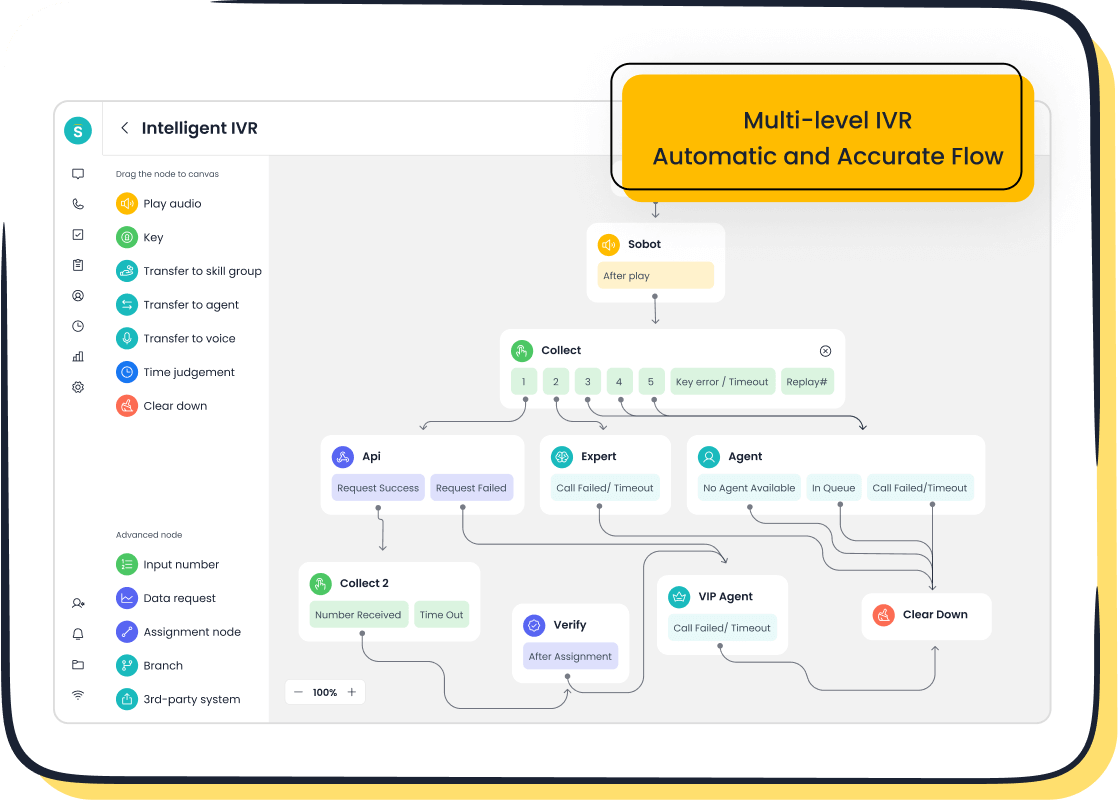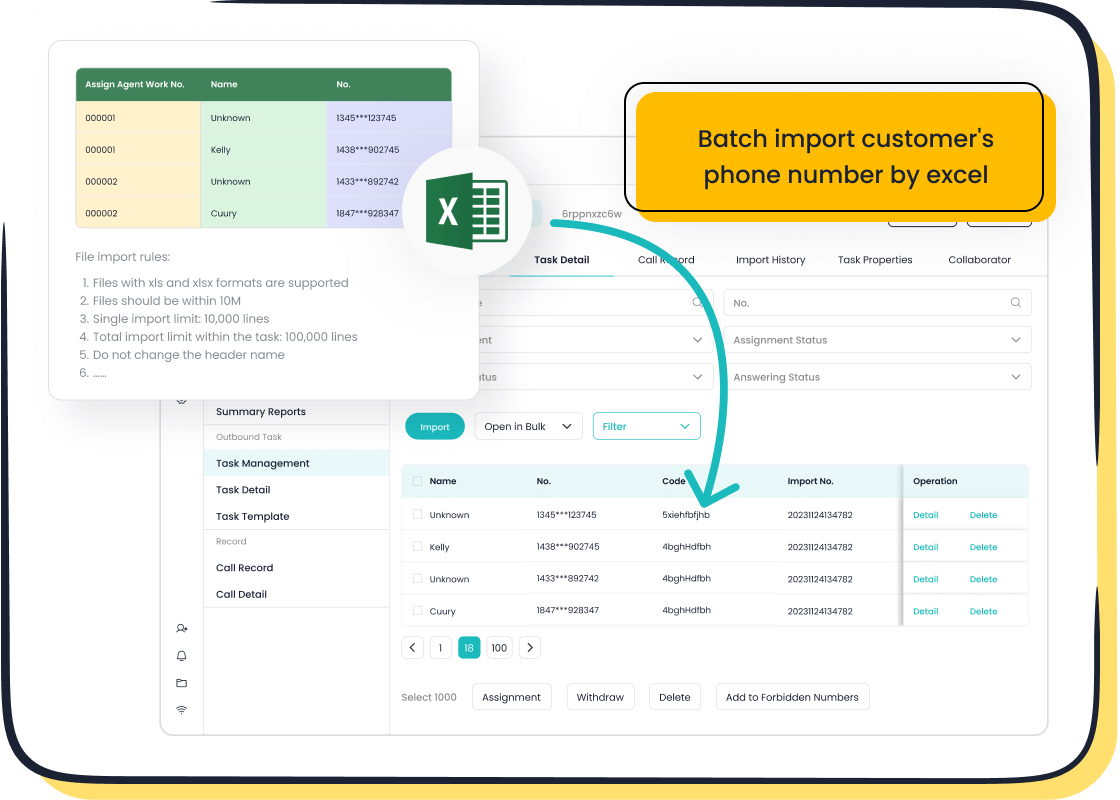Top API Technology Trends Shaping 2025

Application programming interface (API) technology has revolutionized customer service and contact centers. It enables seamless integration between systems, creating efficient workflows and improving customer experiences. Global contact centers now handle over 100 billion calls monthly, showcasing the immense scale of operations. However, approximately one in every 1,700 calls is flagged as fraudulent, highlighting the need for secure and innovative solutions.
Staying updated on API trends is vital for businesses. APIs drive innovation and enhance user experiences, which are critical for improving customer interactions. By adopting strategies like API-First development, you can create flexible, secure, and user-friendly applications. This approach not only boosts operational efficiency but also ensures your business remains competitive in a rapidly evolving landscape.

Sobot, a leader in intelligent contact center solutions, leverages API technology to deliver scalable and secure platforms. Its Voice/Call Center exemplifies how APIs can transform customer interactions through features like AI-powered voicebots and global network support.
Advancements in API Security
Zero Trust Security Models
Passwordless Authentication for Enhanced Security
Zero-trust models have revolutionized how you approach API security. Passwordless authentication is a key advancement, eliminating the risks associated with weak or stolen passwords. Instead of relying on traditional credentials, you can implement methods like one-time codes or device-based authentication. These approaches enhance security by reducing vulnerabilities while improving user convenience. For example, integrating passwordless systems into customer-facing APIs ensures seamless and secure access for your users.
Biometric Authentication in Customer-Facing APIs
Biometric authentication takes zero-trust models a step further. By using unique identifiers like fingerprints or facial recognition, you can ensure only authorized users access sensitive data. This method aligns with zero-trust principles by verifying every access request. For customer-facing APIs, biometric authentication not only strengthens security but also enhances user experience by offering quick and reliable access.
AI-Powered Threat Detection
Real-Time Monitoring and Predictive Analytics
AI-powered systems have transformed real-time threat analysis in API security. These systems continuously monitor API activity, identifying anomalies and potential threats instantly. Predictive analytics further enhances this process by forecasting risks based on historical data. For example, AI can detect unusual patterns in API usage, such as repeated failed login attempts, and take immediate action to mitigate risks. This proactive approach ensures your APIs remain secure and operational.
Securing Customer Data in Contact Centers

AI also plays a crucial role in protecting customer data within contact centers. By automating threat detection, you can identify vulnerabilities like forgotten endpoints or unauthorized API access. AI systems reduce false positives, ensuring accurate and efficient threat management. For instance, Sobot’s Voice/Call Center leverages AI to secure customer interactions, offering encrypted data transfer and real-time monitoring to safeguard sensitive information.
API Security Standards
OAuth 2.1 and Emerging Protocols
OAuth 2.1 has become a cornerstone of modern API security. It simplifies authentication while maintaining robust protection against unauthorized access. Emerging protocols now address evolving threats, such as unrestricted resource consumption and unsafe API usage. By adopting these standards, you can ensure your APIs comply with the latest security trends, safeguarding both your operations and customer data.

API Gateway Enhancements for Contact Center Security
API gateways are essential for enforcing zero-trust models. They provide authentication, authorization, and encryption, ensuring secure API management. Advanced features like DDoS protection and real-time threat analysis further enhance their capabilities. For contact centers, these gateways streamline operations while maintaining high levels of security. Sobot’s solutions, for instance, integrate seamlessly with API gateways to deliver secure and efficient customer interactions.
AI Integration in API Development and Management
AI-Driven API Design
Automated Code Generation for Faster Development
AI-driven solutions are transforming how you approach API development. By automating the analysis of API documentation and usage patterns, AI suggests improvements and generates code snippets. This process reduces development time and enhances the quality of APIs. For example, AI tools can identify inconsistencies in API design and propose fixes, ensuring alignment with business needs.
Key benefits include:
- Increased efficiency through automation.
- Enhanced accuracy by minimizing human errors.
- Faster time-to-market by streamlining processes.
These advancements in AI-augmented API development allow you to focus on innovation while maintaining high standards of reliability.
AI-Assisted Testing and Debugging
Testing and debugging are critical in API development. AI simplifies these tasks by generating automated test cases based on API specifications and historical data. It prioritizes critical tests, enabling you to identify potential issues quickly. For example, AI can predict failure points by analyzing past test results and offer insights for resolution. This approach ensures comprehensive coverage and improves API reliability, saving time and resources.
Intelligent API Management Trends
Predictive Analytics for API Performance
Emerging API management trends emphasize the use of AI and machine learning to optimize performance. Predictive analytics analyzes traffic data and forecasts usage patterns, helping you allocate resources effectively. For instance, AI can detect anomalies in real-time, ensuring your APIs remain secure and reliable under varying conditions. This proactive approach enhances the overall API ecosystem, making it more adaptable to evolving demands.
AI-Powered Documentation for Seamless Integration
AI-powered documentation tools simplify integration by generating clear and consistent API documentation. These tools analyze API usage and provide real-time updates, ensuring developers have access to the latest information. For example, Sobot’s Voice/Call Center benefits from seamless integration capabilities, supported by AI-enhanced documentation. This ensures faster onboarding and reduces the learning curve for developers.
AI in Customer-Facing APIs
Chatbot APIs with Advanced NLP for Customer Support
AI-powered chatbot APIs are revolutionizing customer support. With advanced natural language processing (NLP), these chatbots understand intent and provide instant responses to common inquiries. This reduces the workload on human agents and improves customer satisfaction. For example, Sobot’s Chatbot leverages AI to handle repetitive tasks, allowing agents to focus on complex issues. This approach ensures faster resolutions and cost savings for businesses.

AI-Driven Personalization in Sobot's Voice/Call Center
Personalization is a key trend in customer-facing APIs. AI analyzes customer data, such as interaction history and preferences, to deliver tailored experiences. Sobot’s Voice/Call Center uses AI to personalize interactions, enhancing customer satisfaction. For instance, AI can prioritize calls based on customer sentiment, ensuring timely and effective support. This proactive approach not only improves service quality but also strengthens customer loyalty.
Diversification of API Standards and Architectural Styles
GraphQL for Customer-Centric Applications
Real-Time Data Fetching for Enhanced Customer Interactions
GraphQL has emerged as a game-changer for customer-centric applications. Unlike traditional REST APIs, GraphQL allows you to fetch only the data you need in real-time. This reduces unnecessary data transfer, improving performance and response times. For instance, when managing customer interactions in a contact center, GraphQL enables you to retrieve customer details, interaction history, and preferences in a single request. This streamlined approach ensures faster resolutions and enhances the overall customer experience.
Benefits for Unified Contact Center Solutions
GraphQL's flexibility makes it ideal for unified contact center solutions. Its strongly typed schema ensures data consistency, reducing errors during API communication. You can avoid over-fetching and under-fetching by tailoring queries to specific needs. Additionally, GraphQL APIs are introspective, allowing automatic documentation generation. This simplifies integration and maintenance. For example, Sobot’s Voice/Call Center could leverage GraphQL to unify customer data across channels, enabling agents to deliver seamless and personalized support.
AsyncAPI for Event-Driven Architectures
Use Cases in Customer Service Platforms
AsyncAPI supports event-driven architectures, which are essential for modern customer service platforms. It describes messaging interfaces, enabling real-time communication between systems. For example, you can use AsyncAPI to design specifications for chat notifications or call routing in a contact center. This ensures compliance with organizational standards and promotes collaboration among developers. By adopting AsyncAPI, you can create responsive systems that handle high volumes of customer interactions efficiently.

Enhancing Scalability in Sobot's Voice/Call Center
Event-driven architectures powered by AsyncAPI enhance scalability in platforms like Sobot’s Voice/Call Center. AsyncAPI facilitates seamless integration of messaging interfaces, allowing the system to handle spikes in call volumes during peak periods. This ensures uninterrupted service and improved customer satisfaction. With features like real-time monitoring and smart call routing, Sobot’s solution exemplifies how AsyncAPI can optimize scalability and performance in customer service environments.
REST and Its Evolution
Modernizing Legacy Systems with RESTful APIs
RESTful APIs remain a cornerstone of API development, especially for modernizing legacy systems. They provide a standardized way to integrate older systems with new technologies. For example, you can use RESTful APIs to connect a legacy CRM with a modern contact center platform. This ensures data consistency and enhances user experience. REST APIs also support microservices architecture, enabling you to build scalable and modular applications.
Combining REST with Emerging Standards
REST continues to evolve by integrating new standards like OAuth for security and serverless architectures for efficiency. These advancements enhance interoperability and future-proof your systems. For instance, combining REST with GraphQL or AsyncAPI allows you to leverage the strengths of each approach. Sobot’s Voice/Call Center demonstrates this by integrating RESTful APIs with AI-driven features, ensuring secure and efficient customer interactions.
Rise of Serverless Architectures and Edge Computing
Serverless APIs for Scalability
Cost Efficiency in Customer Support Systems
Serverless APIs offer significant cost advantages for customer support systems. By eliminating the need for overprovisioning, you only pay for the resources you use. This approach optimizes expenses during periods of fluctuating demand. For example, during peak shopping seasons, serverless APIs automatically scale to handle increased traffic, ensuring consistent performance. This dynamic scaling not only reduces operational costs but also enhances user satisfaction by maintaining seamless interactions.
| Benefit | Description |
|---|---|
| Dynamic Scaling | Serverless APIs can adjust to varying traffic levels, ensuring performance. |
| Cost Efficiency | Reduces operational costs by eliminating the need for overprovisioning. |
| Improved User Experience | Consistent performance enhances user satisfaction during high demand. |

Simplified API Deployment in Sobot's Voice/Call Center
Sobot’s Voice/Call Center demonstrates how serverless APIs simplify deployment. With serverless architecture, you can quickly integrate APIs without managing underlying infrastructure. This allows you to focus on enhancing customer interactions rather than server maintenance. For instance, Sobot’s platform leverages serverless APIs to enable features like smart call routing and real-time monitoring. These capabilities ensure reliable and efficient customer support, even during high call volumes.
Edge Computing for Low Latency
Real-Time Customer Interactions in Contact Centers
Edge computing positions computation and data storage closer to users, reducing latency. This proximity is crucial for real-time customer interactions in contact centers. By minimizing the distance data must travel, edge computing ensures faster response times. For example, it enables real-time transactions like call routing or chatbot responses, improving the overall customer experience. Additionally, caching frequently accessed data at the edge further boosts performance, ensuring seamless interactions.
Improved API Performance at the Edge
Edge computing enhances API performance by processing data locally. This reduces the reliance on distant servers, which can slow down operations. In contact centers, this improvement ensures APIs deliver quick and reliable responses. For instance, Sobot’s Voice/Call Center benefits from edge computing by providing real-time monitoring and analytics. These features help agents resolve issues faster, improving service quality and customer satisfaction.
Hybrid Architectures
Combining Serverless and Edge for Flexibility
Hybrid architectures combine the scalability of serverless APIs with the low latency of edge computing. This approach offers flexibility, allowing you to optimize performance based on specific needs. For example, you can use serverless APIs for dynamic scaling during high traffic and edge computing for real-time interactions. This combination ensures your contact center remains efficient and responsive, regardless of demand fluctuations.
Use Cases in Global Contact Centers
Global contact centers benefit greatly from hybrid architectures. By integrating serverless and edge computing, you can handle high call volumes while maintaining low latency. For instance, Sobot’s Voice/Call Center uses this approach to support real-time interactions across multiple regions. With features like global number availability and smart call routing, the platform ensures consistent performance, enhancing customer satisfaction worldwide.
Sustainability in API Design
Green Coding Practices
Energy-Efficient API Development
Green coding practices prioritize efficiency to reduce energy consumption during API development. By allocating resources effectively, you can minimize waste and optimize performance. Techniques like caching and batching requests lower computational overhead, ensuring APIs operate with minimal energy use. For example, smaller data packets reduce network load, allowing servers to process requests faster and enter low-power states sooner. This approach not only conserves energy but also supports sustainable scalability. Sobot’s Voice/Call Center exemplifies this by using efficient API designs to handle millions of daily interactions while maintaining a 99.99% uptime.
Reducing Carbon Footprint in Contact Center Operations
Optimizing APIs can significantly lower the carbon footprint of contact centers. Smaller data payloads and rate-limiting strategies reduce server strain, decreasing CPU and memory usage. AI-driven systems further streamline processes, improving efficiency and cutting energy consumption. For instance, Sobot’s solutions leverage smart sensors and cloud-based technologies to enhance operational sustainability. These practices ensure your contact center remains eco-friendly without compromising performance.
Sustainable API Infrastructure
Leveraging Renewable Energy in Data Centers
Data centers play a critical role in API infrastructure. Transitioning to renewable energy sources like solar or wind can drastically reduce their environmental impact. Optimized APIs also use hardware resources more effectively, reducing the need for additional servers. This approach aligns with global sustainability goals while maintaining high levels of security and performance. Sobot’s global network, supported by 110 points of presence, demonstrates how sustainable infrastructure can power reliable and scalable contact center solutions.
Optimizing API Workloads for Efficiency
Efficient workload management is essential for sustainable API operations. By minimizing data payloads and optimizing API implementation, you can lower processing power requirements. This reduces energy consumption in data centers and network traffic. For example, Sobot’s Voice/Call Center uses smart call routing and real-time monitoring to manage workloads effectively. These features ensure seamless customer interactions while conserving resources, making your operations both cost-effective and environmentally friendly.
Business Benefits of Sustainable APIs
Enhancing Brand Reputation with Eco-Friendly Practices
Adopting sustainable APIs showcases your commitment to environmental responsibility, enhancing your brand’s reputation. Reusing existing APIs avoids duplication, reducing resource consumption and development costs. Customers increasingly value eco-conscious businesses, making sustainability a key differentiator. Sobot’s solutions, designed with green coding principles, help businesses align with these expectations while delivering exceptional customer experiences.
Cost Savings Through Energy Efficiency in Sobot's Solutions
Sustainable APIs offer significant cost savings by reducing energy consumption. Optimizing data payloads lowers processing power needs, cutting operational expenses. Sobot’s Voice/Call Center demonstrates this by utilizing efficient APIs to handle high call volumes without additional infrastructure. This approach not only reduces costs but also supports long-term growth, ensuring your business remains competitive in a rapidly evolving market.
The API trends of 2025 are reshaping customer service and contact center operations. Key advancements like AI-powered chatbots, real-time analytics, and omnichannel communication are enhancing efficiency and customer engagement. For example, unified customer profiles now allow agents to access complete interaction histories, ensuring seamless support. Businesses leveraging these trends can deliver personalized experiences, reduce operational bottlenecks, and foster customer loyalty.
Sobot’s Voice/Call Center exemplifies how APIs drive innovation. With features like smart call routing and AI-powered voicebots, it ensures secure and scalable customer interactions. By adopting these solutions, you can stay ahead in a competitive landscape while meeting evolving customer expectations.
FAQ
What is an API, and why is it important for businesses?
An API, or Application Programming Interface, allows different software systems to communicate. It simplifies integration, enabling businesses to streamline operations and enhance customer experiences. For example, Sobot’s Voice/Call Center uses APIs to unify customer data, ensuring seamless interactions across channels.
How do the latest API practices improve customer service?
The latest API practices, like AI integration and real-time analytics, optimize customer service. They enable faster response times and personalized interactions. For instance, Sobot’s AI-powered voicebots analyze customer intent, ensuring efficient call routing and improved satisfaction.
How can businesses ensure API security?
You can secure APIs by adopting zero-trust models, using OAuth 2.1, and implementing real-time threat detection. Sobot’s solutions, such as encrypted data transfer in its Voice/Call Center, demonstrate how robust security measures protect sensitive customer information.
What role does AI play in API development?
AI automates tasks like code generation, testing, and debugging, reducing development time. It also enhances API management with predictive analytics. Sobot’s AI-driven APIs, for example, improve performance and scalability in customer contact solutions.
How does Sobot leverage APIs to enhance customer interactions?
Sobot integrates APIs into its products, like the Voice/Call Center, to deliver features such as smart call routing and real-time monitoring. These capabilities ensure secure, scalable, and efficient customer interactions, helping businesses improve satisfaction and loyalty.
See Also
Best Cloud Contact Center Solutions You Should Consider in 2024
Leading Websites Implementing Chatbots This Year in 2024
Comparative Analysis of Live Chat Solutions for 2024
